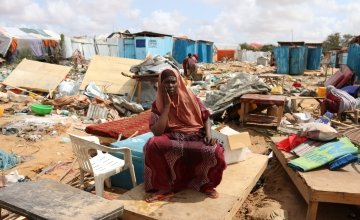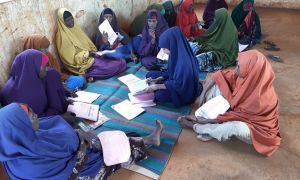
Read our 2024 annual report

Knowledge Hub
Enhancing Integration of Displacement Affected Communities in Somalia - Endline Evaluation 2020
The Enhancing Integration of Displacement Affected Communities (EIDACS) initiative was a Durable Solutions (DS) consortium funded by the EU Emergency Trust for Africa. Concern Worldwide was the lead agency with Gargaar Relief and Development Organisation (GREDO), Norwegian Refugee Council (NRC), Danish Refugee Council (DRC) and the Regional Durable Solutions Secretariat (ReDSS) as partners.

The overall objective of the programme was to create a conducive environment to reach durable solutions for displacement-affected communities in South-West State, Somalia. The consortium came together in 2015 to design comprehensive durable solutions approaches for the Somalia context, and addressing negative root causes of mixed-migration.
The EIDACS contract, initiated in March 2017, closed in May 2020. Consultancy agency Consilient was contracted to go through a deep reflection process after three years of a Durable Solutions pilot experience in a very new and innovative sector. The purpose of this evaluation is to support this process reflecting on the successes and shortcomings of EIDACS A and B activities.
Findings
Process Evaluation
A key output of this evaluation is an assessment of the process by which EIDACS was implemented. The programme worked within the durable solutions framework, but also sought to use new approaches to organizing its interventions, selecting activities, and targeting beneficiaries. Two components of the programme’s design stand out as being particularly effective: first is the area-based approach, which brought together interventions across multiple sectors and applied them to a single area. This proved valuable as it provided a more comprehensive solution to the IDP crisis and allowed deeper coordination between implementing organizations and the government. Second, the development of DAC forums, their selection from within existing community groups, and their activity level were found very effective. These activities ensured community involvement in programme design, effective and fair beneficiary targeting, and provided a mechanism for community feedback. Third, the government engagement strategy was found to be effective in engaging with the local government institutions in the incubator areas. The programme was able to enhance government capacities to pursue the DS agenda for mixed-migration flows and, through effective communication, secured a continued government buy-in and commitment to the cause.
In general, the programme was well-designed and contextually-appropriate. Moreover, the programme was adapted to local circumstances through the inputs of DAC forum members drawn from the communities they represent. Inclusion was broad and beneficiary targeting appears to have been fair, without reinforcing existing tensions through exclusion of host communities and gender, age, or clan inequalities.
On the other hand, there are aspects of programme implementation that could be substantially improved. Concerns regarding the organization and management of the consortium, its efficiency, and the level of intra-consortium coordination appear to be valid, with significant time and energy invested into cross-partner coordination that might have been better invested elsewhere. Coordination with other NGOs outside of the consortium fit with standard practices, but intraconsortium coordination may have not been conducted most-efficiently, suggesting that the consortium may have incurred organizational, coordination, and other costs that were not fully offset by the primary benefits – comparative advantage within different sectoral areas – commonly touted in favour of consortia.
OECD DAC Criteria
Key findings in this report indicate that activities aimed at housing, land and property rights protection and assistance remain highly relevant in both locations. Sanitation and WASH interventions remain relevant to community needs in both locations. Improved access to health care continues to be a priority in Afgoye, while improved access to realistic livelihoods remains highly relevant to populations in Baidoa.
The majority of the activities were found to have a positive impact on community cohesion. For example, distribution of land titles and CEC engagement in mediation between parents from IDP and HC both had a positive effect on reduction of community conflicts. Also, participation of community members during awareness rising on sanitation and health care and in activities aimed to improve quality of the environment further improved interactions within communities. In the same way, joint participation in self-help groups by both HC and IDPs - and the fact that these groups were able to support community members regardless of their displacement status – are indicative of positive impacts on social cohesion.
Main findings indicate that activities aimed at provision of basic services reached the most people (including direct and indirect beneficiaries) and the second most impactful activity in terms of numbers of reached beneficiaries was livelihoods support. Some improvements towards a more conducive environment for DACs were observed in health and WASH and in generating realistic livelihoods in intervention areas. WASH and health support saw the most progress in improved community knowledge on health issues, improved sanitation practices and hygiene practices, reduced open defecation and access to free water with newly drilled boreholes and rehabilitation of existing water sources. However, respondents in Afgoye frequently complained about an insufficient number of latrines and water sources, and collapsed boreholes, which were not repaired. Support provided to communities to improve their access to livelihoods and job opportunities contributed to the resilience of beneficiaries and the ability to address their needs and improve their living standards.
Qualitative interviews revealed the provision of unconditional cash transfers to the most vulnerable IDP families and grant support allowed them to set up small businesses, reimburse their debts, generate savings and pay for school fees. However, quantitative analysis results revealed that there was no change in income level and the only statistically significant and positive change was observed for food insecurity score.
Actual impacts on education are also unclear. For instance, almost all respondents agreed education activities supported children who would have been otherwise excluded from the formal education systems, especially in overcoming barriers such as lack of funds to pay for school fees and negative parental attitudes towards the importance of education. On the other hand, the effect on the quality of education could be limited by the fact that respondents from both IDP and HC frequently reported over-enrolment of children, causing scarcity of learning materials and increased number of children per teacher.
The cost-effectiveness analysis results indicate that the activities with the high impact and low resource intensiveness were provision of health and WASH services and activities targeting realistic livelihoods. Low-cost effectiveness was predominant for activities geared towards the provision of primary education. Overall, while delays in implementation of activities occurred the EIDACS teams seem to have successfully mitigated the negative effect of the delays on the achievement of the project objectives and the ability to meet targets. On the other hand, not all program indicators were ultimately met, such as 1.1 (IASC Framework): percent of target population in community groups with the ability to address or voice their concerns and engage in advocacy and 2.3 (IASC Framework): percentage of target population that reports feeling safe in their community as compared to the host community population. In comparison to other DS consortia peers, the EIDACS efficiency ranked somewhere in the middle, with the consortium’s funding ‘burn-rate’ was at 69% for EIDACS A and 84% for EIDACS B. On the other hand, the rate was above the average of 53%.
The key findings indicate that integration with the host community with equal access to resources consistently progressed over time. Some of the program activities were also identified as likely to remain sustained over time no further inputs required, such as self-help groups and community education committees. On the other hand, persisting gaps in government capacity to fund education, health and WASH services were identified as one of the major obstacles to sustainable change in communities access to basic services. Moreover, lack of eviction prevention mechanisms at the government and lower administrative levels remains as a main obstacle to sustainable improvement of housing situation. Ultimately, continued government support, survival of DAC committees, and lasting community buy-in are all major factors that will influence the sustainability of the EIDACS programme.
IASC / ReDSS Framework Analysis
Key findings from the quantitative analysis indicate that intention to stay in a place of choice, social integration and belonging scores1 have significantly improved since the start of the program. The intention to stay was mostly determined by the length of stay in settlement and food insecurity. Social integration increase was mostly driven by the reported reduction of the legal or administrative obstacles to employment faced by DACs and the fact that the issues presented to local authorities were adequately addressed. Social belonging increased with the reduction of legal or administrative obstacles to employment faced by DACs and length of stay in the settlement.
Several outcome indicators have significantly improved since the start of the program, such as food insecurity scores, unemployment and access to credit. On the other hand, there was a negative and statistically significant change in several outcome indicators, such as the ability to voice concerns and engage in advocacy and sense of security. There was a positive change in one output indicator, measuring the absence of obstacles to accessing employment faced by IDPs. On the other hand, a negative change was observed for DAC committee awareness and obstacles to accessing public services, remittances and assistance faced by IDPs.
Certain indicators related to physical safety have significantly improved since the start of the program, such as social integration and confidence in justice systems, while perceptions of safety have significantly worsened over time. We observed a general improvement of material safety, as food insecurity, unemployment and access to water have significantly improved over time. On the other hand, the proportion of the sample population aware of HLP mechanisms has significantly declined during the second and the third year for program implementation. The results suggest that legal safety has improved for the target population, through improved access to mechanisms to obtain/replace documents.
The Durable Solutions programmes were a feature of Concern’s publication Knowledge Matters – Durable Solutions in Somalia.
Download the evaluation report
The Enhancing Integration of Displacement Affected Communities (EIDACS) initiative is a Durable Solutions (DS) consortium funded by the EU Emergency Trust for Africa. The views expressed herein should not be taken, in any way, to reflect the official opinion of the European Union, and the European Commission is not responsible for any use that may be made of the information it contains.




